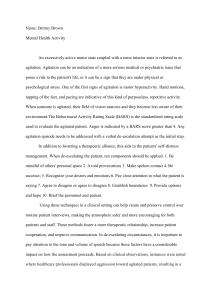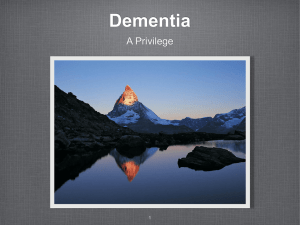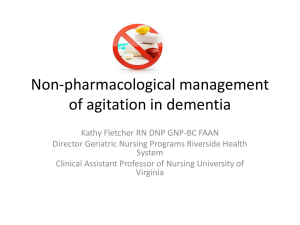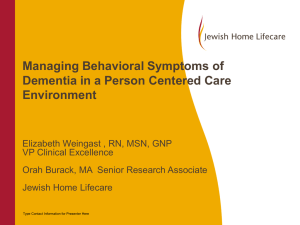Powerpoint
advertisement
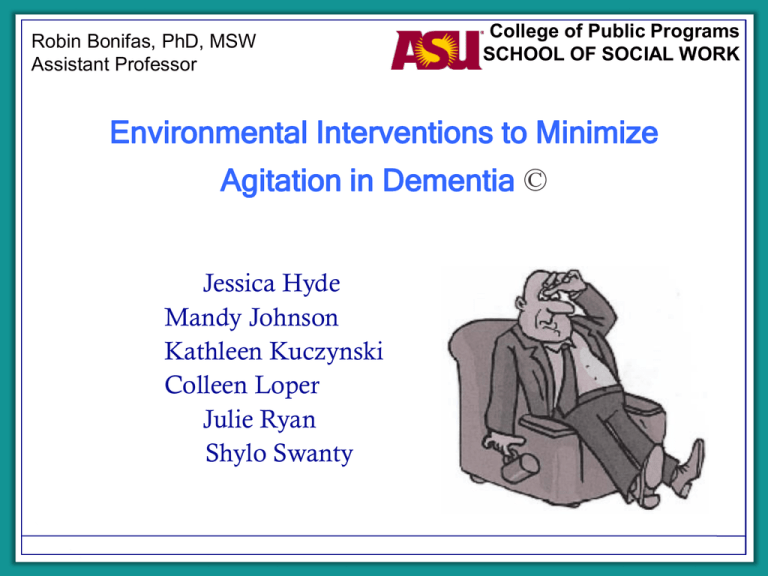
Robin Bonifas, PhD, MSW Assistant Professor College of Public Programs SCHOOL OF SOCIAL WORK Environmental Interventions to Minimize Agitation in Dementia © Jessica Hyde Mandy Johnson Kathleen Kuczynski Colleen Loper Julie Ryan Shylo Swanty Agitation • Agitation refers to a range of behavioral disturbances and symptoms including uncooperativeness with necessary care, aggression, combativeness, shouting, verbal abuse, motor hyperactivity and disinhibition. • Working with these symptoms can be the most stressful aspect of caring for the demented person. • Symptoms can generate feelings of frustration, fear and helplessness in both the patients and their caregivers. • Coping mechanisms may fail and give way to intolerance as family members try to deal with these problems day after day. • Caring and concern can quickly turn to annoyance and outright anger. • Caregivers' lack of understanding and unrealistic expectations compound the problem. Issues • Four problems that can cause agitation: 1. Physical and medical problems 2. Environmental stresses 3. Sleep problems 4. Psychiatric syndromes (psychosis, anger and aggression, depression and anxiety) • In all these situations, a person with dementia is more easily agitated because the brain has physically changed and no longer functions in a healthy manner. Physical and Medical Problems • If a person with dementia has recently become agitated for the first time or has a change from his or her usual behavior, the first thing to look for is a medical or physical problem. • Common physical problems that cause pain, discomfort, worry or lack of sleep can lead to agitation by making the person upset or fatigued. • Sudden illnesses may weaken the brain, causing worsened agitation or delirium.The most common medical problems that can cause agitation or delirium are bladder infections, bad colds, bronchitis or pneumonia and dehydration or poor nutrition. • Older people often take many different medications that can interact with each other. It is crucial to find out if side effects of a new prescription, interactions between medicines or taking the wrong dose have led to a bad reaction. Environmental Stresses • People with dementia are very sensitive to the environment they live in.They are less able to handle changes, uncertainty, and other situations that they could manage when they were well. • Routine is very important, since changes in schedule or rushing can cause extreme disappointment, frustration or fear. • A physically comfortable environment is important. Noisy, poorly lit, or improperly heated areas can cause increased agitation. • The ideal environment for a person with dementia provides clear, calm, comforting structure often not an easy situation to arrange. Sleep Problems • Sleep problems are common in dementia. • One type of problem is insomnia which is trouble falling asleep at night or waking up throughout the night. Conditions such as depression, nervousness,or physical pain can also cause insomnia. • It also helps to keep in mind that many people need less sleep as they age and that a person with dementia has a very hard time finding purposeful things to do during longer waking hours. • Sleep patterns are controlled by an internal clock in the brain that senses day and night and tells us when to be active. However, this clock is often damaged in dementia which is known as “sun downing”. Psychiatric Syndromes • Psychosis, aggression or anger, depression and anxiety are commonly seen in agitated persons suffering from dementia. • Depression is a treatable symptom that is not a “normal” reaction and should not be ignored. • Agitation in depression can include extreme tearfulness, hand wringing and excessive need for reassurance. • An important cause of anxiety maybe the diagnosis of dementia itself, especially in the early stages when a person can feel embarrassed by making mistakes or forgetting things. • They may become especially nervous when they are separated from caregivers, when schedules are changed and when they are rushed or tired. Interventions • Adjustment to the environment is one of the most cost effective way to decrease agitation, conflict, poor sleep, confusion, anxiety and improve cognitive skills. • Sensory enhancement and social contact can be added to the current milieu to decrease restlessness and adverse behaviors. • Communication can greatly decrease confusion. • Little things can make a big difference. Personal Area • Private rooms decrease, confusion and agitation as well as provides a sense of security. • Personalize room to allow for familiarity and continuity with the past and to decrease confusion. • Place pictures around the room with names of family members to increase recognition. • Private rooms allow an individual to sleep better, decrease wandering and confusion at night and provide a quiet place to relax that is their own. • Having the toilet visible from the door will increase recognition about the use of the bathroom. • However, many facilities aren’t able to provide private rooms and therefore considerations should be made for increasing privacy and security in semi-private rooms in other ways. Structured Activities • An increase in activities will reduce restlessness, improve cognitive skills, decrease behaviors and increase interactions with others. • An increase in activities will improve restful sleep at night and relaxation. • Activities in the late afternoon decreases sun downers syndrome. Art & Music Therapy • Allows the individual a sense of expression to overcome cognitive deficits they are experiencing. • Increases language and social interactions with others. • Improves mood and decreases agitation and negative behaviors. • Stimulates the senses, reduces tensions, stress and anxiety. Outdoors • Allow for space to walk and wander on their own. This will decrease the institutional feeling and allow for a sense of control. • Provide walking spaces that are looped back to the building with no dead ends to decrease confusion and from getting lost. • Outdoor activities and access to daylight will decrease behaviors, agitation and improve sleep. • Use a border of plants and bushes rather then fences, this will decrease the feeling of being trapped and the individual is less likely to try to leave. Environmental Modifications • Reduce background noise by removing intercoms, cleaning equipment, telephones and blaring televisions. • Turn on the lights prior to the sun going down. • Use bright colors to allow for easy recognition of the area. Use colored lines on the floor to guide the individual to an area. • Use mobility assisted devices to allow those with difficulties to move throughout the facility. • Organize the facility and pick up articles laying around which will decrease paranoia and feelings that others are taking their items. Dining Room • Allow for the individuals to assist with meal prep and clean up no matter how small the task. • Provide food choices and consistent meal times. • Small tables will increase socialization and feel more like home. • Provide finger food options for those with difficulties using silverware. Conclusion • Always remember the little things can make a big difference. What you do will make a person feel like they are home or in an a facility. • If there is too much going on, there is likely to be an increase in confusion, behaviors and agitation. • Adjust for hearing and vision impairments that arise. • Treat the person as a individual and not a routine.


